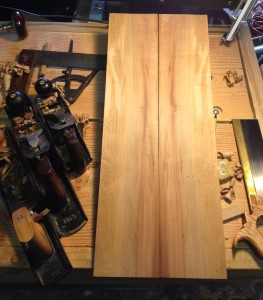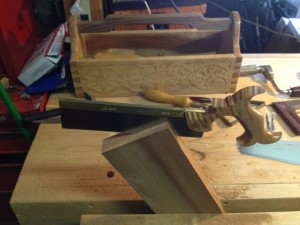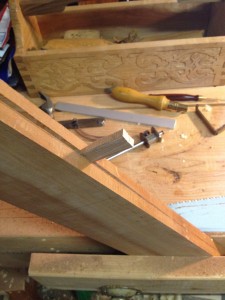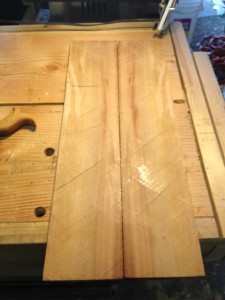Resawing a board by hand
It feels like it’s been a million years since I got down to the shop, but it’s really only been a couple months.  We had our annual family vacation road trip down to San Diego and back which we took three weeks for.  But right before that I’ve been having a lot of worse stress and dramatic changes there that set me back on my heels a bit.  Fortunately things are looking up  again, and I think it’s going to work out.
So, not much woodworking happened while I hunkered down mentally, and slogged through the hard times. Â So I know things are getting better because I made it down to the shop and cut a board in half. Â The long way. Â 🙂
A few months back I picked up some pieces of wood down in Portland, and I have been wanting to get some carving going again. Â I picked out a chunk of Alder, must be about 1″ thick or so, but I didn’t measure the thickness. Â In actual fact, I didn’t measure anything today as I eyeballed stuff or just used my dividers with standard proportions. Â The thick alder board was some nice wood and should be lots of fun to carve, but it was much too thick for making a box out. I don’t own a bandsaw that will do resawing, as the one I bought on sale at the home center is a pile of crap. Â I’ve never had any luck with this thing, and I’ve spent hours trying to get it cutting even remotely straight. Â Plus, it scares the crap out of me since I’m clumsy on a good day and I happen to like my fingers. Â (more on this later).
I’ve been thinking about making a frame saw, but I really wanted to spend some time working wood and not making yet another tool. Â When I do though, I think I’ll be using this as a guide: Â http://www.hyperkitten.com/woodworking/frame_saw.php3Â Josh is an amazing tool peddler, and apparently also works the wood too.
I have a 5 1/2 Point rip saw from Tools for Working Wood that I thought might do the trick, and I’d seen Roy Underhill do it on his show a few times so I jumped in and tried it.  And just like Roy I managed to nick my finger and draw a little blood.  Had I been using the Bandsaw, I’d probably be singing the Frodo the Nine Fingered ballad while I asked my wife to take me to the ER.  Anyway, back to woodworking shall we?
To get it started I sized the length of my board using dividers, cross cut it to length and found the middle line with marking gauge. Â Running the line around all four sides is essential, as we’ll be flipping this around a lot and we need to have that reference line. Â To start the cut, I clamped it up in my face vise at an angle, and used my dovetail saw (the only rip back saw I had handy) to carefully but quickly start the cut. Â I needed to create the first line for the saw to track into, and once I had the corner cut I followed up with the Rip hand saw. Â The trick I found was to let the saw and gravity do most of the work, as it will naturally follow the track left by the last saw, a trick we use through the whole board actually. Â Because once you cut through the corner you unclamp the board, reverse it in the vise retaining the same angle and cut down the other side. Â You keep flipping it back and forth like this because the front half of the saw is cutting wood, but the forward half is in the track of the last cut you made keeping it pretty much on the line you want to follow.
I kept flipping it back and forth until the vise wasn’t grabbing it firmly anymore and then flipped it end to end to start on the other side. Â This is why we needed to mark all four edges of the board. Â A couple of tricks I tried with excellent results are as follows:
– Waxing the sawblade kept it running smoothly in the cut. Â I have a block of beeswax I rub on it every time I switched the board.
– Angling the tip of the blade upwards a little helped the cut a lot, and prevented binding.
– I used a little wedge at the top of the board to open a little, which also helped keep the saw from binding.
After my cuts met up from the other side, i was able to pop them apart and see what the inside looked like. Â It wasn’t that bad as I’d been able keep pretty much on my center line through the magic of tracking.
After that it was a pretty simple matter of planning down the saw marks, and cleaning up the edges with my Fore and Smooth planes. Â All in all, it took me about an hour to complete this including thinking it through, then marking, cutting and planing the board. Â If I had a fancy bandsaw it would be quicker I’m sure, but for me since I don’t own a decent band saw, this was a pretty good result for the effort. Â Plus, now I know how. Â I’m going to make a box out of this, probably carved on all four sides. Â Not sure what I’ll use for the lid, but I’ll deal with that later once I get through the carving.
Badger
4 Comments
Comments are Disabled






Nicely done, my arm is sore just from the pictures 🙂
It wasn’t actually that bad. I let the saw and gravity do most of the work, when I remembered and quit trying to over think it.
Beautiful work. I’m still too poor for a bandsaw, and as a budding luthier, I sort of see the appeal in doing as much work as possible by hand. Thanks for sharing this!
I all too often see younger men trying to use a saw like a battle axe, gravity is all it takes and the end result is so much cleaner